A recent piece of development work made me think about Spring Autowiring. The Java code and the Spring configuration for the application I was developing were not aligned, but, as if by magic, everything seemed to be working fine.
I decided that I wanted an explanation, and results were hard to find on the usual sources of wisdom that we developers turn to (Google and Stack Overflow). I set out to recreate the same situation in a simple project. This would help me get to the bottom of what was really happening, and I’d learn more about Spring while I was doing so.
This post focusses on something documented as a note in the Spring documentation. This is that, as of Spring Framework 4.3, Spring does not require the @Autowired anotation if a target bean only defines one constructor. The examples below work through the mechanisms used in Spring Autowiring, looking into the code to see what’s really happening. Firstly let’s inject a dependency using the @Autowired annotation.
Autowiring with @Autowired and @Service
Imagine an online blog full of interesting articles about software development and technology. Each article on the blog needs to be assigned an author. If the server was a Spring application written in Java it would be useful to have an AuthorService.
package com.github.pagram1975.autowiremagic;
import com.github.pagram1975.autowiremagic.model.web.Author;
import java.util.*;
public class AuthorService {
private Map<Integer, Author> map = new HashMap<> ();
public AuthorService () {
Author zinat = new Author(1, "Zinat", "Wali");
Author jeanSacha = new Author(2, "Jean-Sacha", "Melon");
Author steven = new Author(3, "Steven", "Waterman") ;
Author sam = new Author(4, "Sam", "Hogarth");
Author callum = new Author(5, "Callum", "Akehurst-Ryan");
Author james = new Author(6, "James", "Grant");
map.put(zinat.getAuthorId(), zinat);
map.put(jeanSacha.getAuthorId(), jeanSacha);
map.put(steven.getAuthorId(), steven);
map.put(sam.getAuthorId(), sam);
map.put(callum.getAuthorId(), callum);
map.put(james.getAuthorId(), james);
}
public Collection<Author> getAllAuthors() {
return map.values();
}
public Author getAuthorForAuthorId(int authorId) {
Author result = map.get(authorId);
if (result == null) {
return Author.UNKNOWN_AUTHOR;
}
return result;
}
}
The Spring application would have an AuthorController class which exposes a couple of endpoints to display all authors and also individual authors by ID. We’d need the AuthorService to be available to this controller, and this is easily done using @Autowired.
package com.github.pagram1975.autowiremagic.autowired;
import com.github.pagram1975.autowiremagic.AuthorService;
import com.github.pagram1975.autowiremagic.model.web.Author;
import org.springframework.beans.factory.annotation.Autowired;
import org.springframework.web.bind.annotation.GetMapping;
import org.springframework.web.bind.annotation.PathVariable;
import org.springframework.web.bind.annotation.RequestMapping;
import org.springframework.web.bind.annotation.RestController;
import java.util.ArrayList;
import java.util.List;
import java.util.stream.Collectors;
@RestController
@RequestMapping("authors")
public class AuthorController {
@Autowired
private AuthorService authorService;
@GetMapping("/")
public List<Author> getAllAuthors() {
List<Author> list = new ArrayList<>(authorService.getAllAuthors());
return list;
}
@GetMapping("/{id}")
public Author getAuthorById(@PathVariable int id) {
return authorService.getAuthorForAuthorId(id);
}
}
Spring will only be able to complete the dependency injection for the AuthorService if it is told to create an instance of the AuthorService in the application configuration. This can be done by adding the @Service annotation to the AuthorService class.
...
import org.springframework.stereotype.Service;
...
@Service
public class AuthorService {
...
}
That’s all that is required. The application can be started and the local endpoint, http://localhost:8080/authors/, will display the list of authors. Spring is filling in the dependency that AuthorController has on AuthorService as if by magic.
So, what’s really going on? To see what’s happening enable TRACE level logging in the application. This is simply a case of passing --trace as a program argument at runtime. In IntelliJ Idea that looks like this (open these images in a new tab to see them in more detail).

The trace logging contains some lines that show exactly where the @Autowired injection was processed and the AuthorService dependency was resolved.
TRACE 34936 --- [ main] o.s.b.f.annotation.InjectionMetadata : Processing injected element of bean 'authorController': AutowiredFieldElement for private com.github.pagram1975.autowiremagic.AuthorService com.github.pagram1975.autowiremagic.autowired.AuthorController.authorService
TRACE 34936 --- [ main] o.s.b.f.s.DefaultListableBeanFactory : Returning cached instance of singleton bean 'authorService'
TRACE 34936 --- [ main] f.a.AutowiredAnnotationBeanPostProcessor : Autowiring by type from bean name 'authorController' to bean named 'authorService'
TRACE 34936 --- [ main] o.s.b.f.s.DefaultListableBeanFactory : Finished creating instance of bean 'authorController'
It’s possible to inspect what’s happening in detail by adding a breakpoint in the AutowiredAnnotationBeanPostProcessor class that Spring uses and debugging the process. The trace log provides some text to search for to set the initial breakpoint (there must be a statement that includes logger.trace("Autowiring by type...).
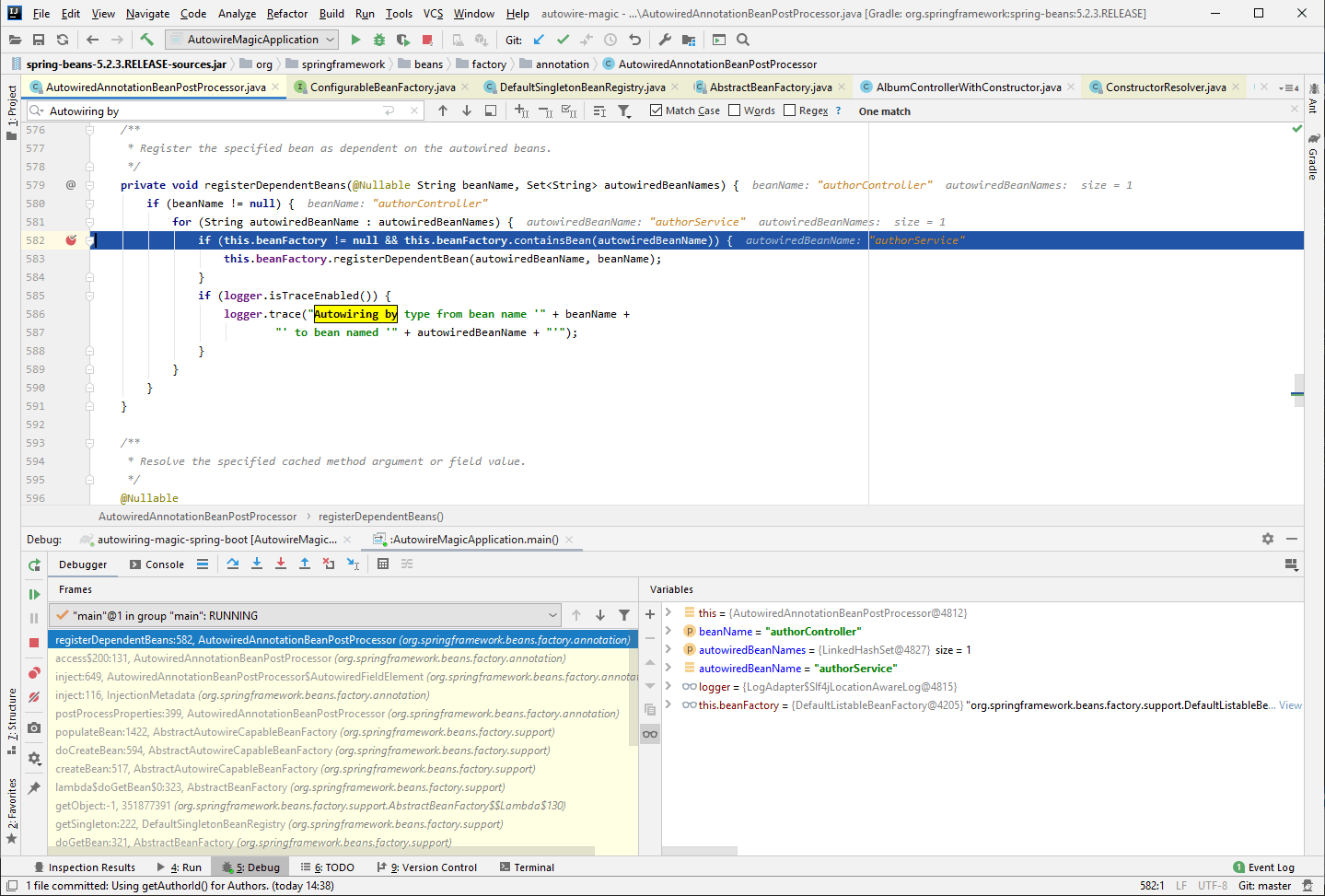
This shows that Spring is aware that the AuthorController is dependent on the AuthorService so it registers this dependency then returns up the stack.
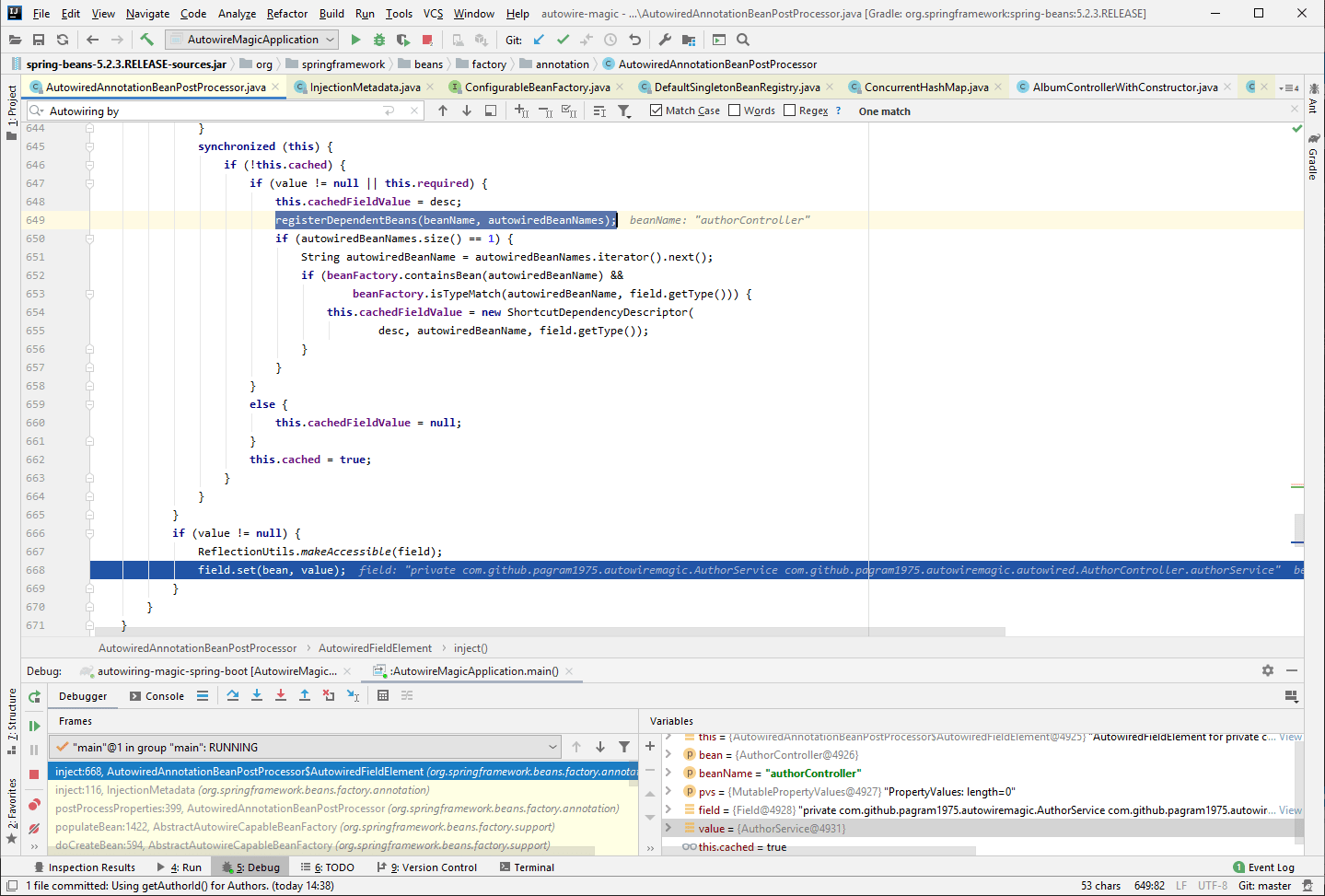
Stepping back up through the stack, it’s in the AutowiredAnnotationBeanPostProcessor$AutowiredFieldElement.inject() method that the dependency is injected. Spring has looked in the BeanFactory to see what beans are defined. It identifies that it has one bean, the AuthorService, that is the correct type for the AuthorController.authorService field. Then it uses good old Java reflection and calls Field.set(Object obj, Object value) to inject the dependency. Not so magical after all.
Autowiring with a single constructor
What happens if there is an AuthorControllerWithConstructor defined that doesn’t use the @Autowired annotation to resolve its dependency on the AuthorService. What magic does Spring use in that situation? First of all there needs to be a new class.
package com.github.pagram1975.autowiremagic.autoconstructor;
import com.github.pagram1975.autowiremagic.AuthorService;
import com.github.pagram1975.autowiremagic.model.web.Author;
import org.springframework.web.bind.annotation.GetMapping;
import org.springframework.web.bind.annotation.PathVariable;
import org.springframework.web.bind.annotation.RequestMapping;
import org.springframework.web.bind.annotation.RestController;
import java.util.ArrayList;
import java.util.List;
import java.util.stream.Collectors;
@RestController
@RequestMapping("authorswithconstructor")
public class AuthorControllerWithConstructor {
/* Note - No autowired annotation needed. */
private AuthorService authorService;
/* This is the only constructor available to Spring Boot,
* so this is the one Spring Boot will use. */
public AuthorControllerWithConstructor(AuthorService authorService) {
this.authorService = authorService;
}
@GetMapping("/")
public List<Author> getAllAuthors() {
List<Author> list = new ArrayList<>(authorService.getAllAuthors());
return list;
}
@GetMapping("/{id}")
public Author getAuthorById(@PathVariable int id) {
return authorService.getAuthorForAuthorId(id);
}
}
To make it clearer which beans are defined in the project I decided to define all the service beans in an XML configuration. This is very simple for the AuthorService.
<?xml version="1.0" encoding="UTF-8"?>
<beans xmlns="http://www.springframework.org/schema/beans"
xmlns:xsi="http://www.w3.org/2001/XMLSchema-instance"
xsi:schemaLocation="
http://www.springframework.org/schema/beans
http://www.springframework.org/schema/beans/spring-beans.xsd">
<!-- Comment out the bean definition below if you annotate the AuthorService class with @Service.
Duplicate the bean definition below (with a different name) to see ambiguity cause an error. -->
<bean name="autowire.AuthorService" class="com.github.pagram1975.autowiremagic.AuthorService"/>
</beans>
That’s all that is required. The application can be started and the local endpoint, http://localhost:8080/authorswithconstructor/, will display the list of authors. Spring is calling the constructor in AuthorController and passing in the AuthorService as a parameter as if by magic.
So, what’s really going on? This time the TRACE level logging in the application provides little detail.
TRACE 28728 --- [ main] o.s.b.f.s.DefaultListableBeanFactory : Creating instance of bean 'authorControllerWithConstructor'
TRACE 28728 --- [ main] o.s.b.f.s.DefaultListableBeanFactory : Returning cached instance of singleton bean 'autowire.AuthorService'
DEBUG 28728 --- [ main] o.s.b.f.s.DefaultListableBeanFactory : Autowiring by type from bean name 'authorControllerWithConstructor' via constructor to bean named 'autowire.AuthorService'
TRACE 28728 --- [ main] o.s.b.f.s.DefaultListableBeanFactory : Eagerly caching bean 'authorControllerWithConstructor' to allow for resolving potential circular references
Note - the singleton bean
autowire.AuthorServicehas already been cached by Spring at the point in time when theAuthorControllerWithConstructoris being created. This is because it is included in the beans definition.
It’s possible to see how Spring is creating the AuthorControllerWithConstructor by adding a breakpoint in the constructor and debugging the process.
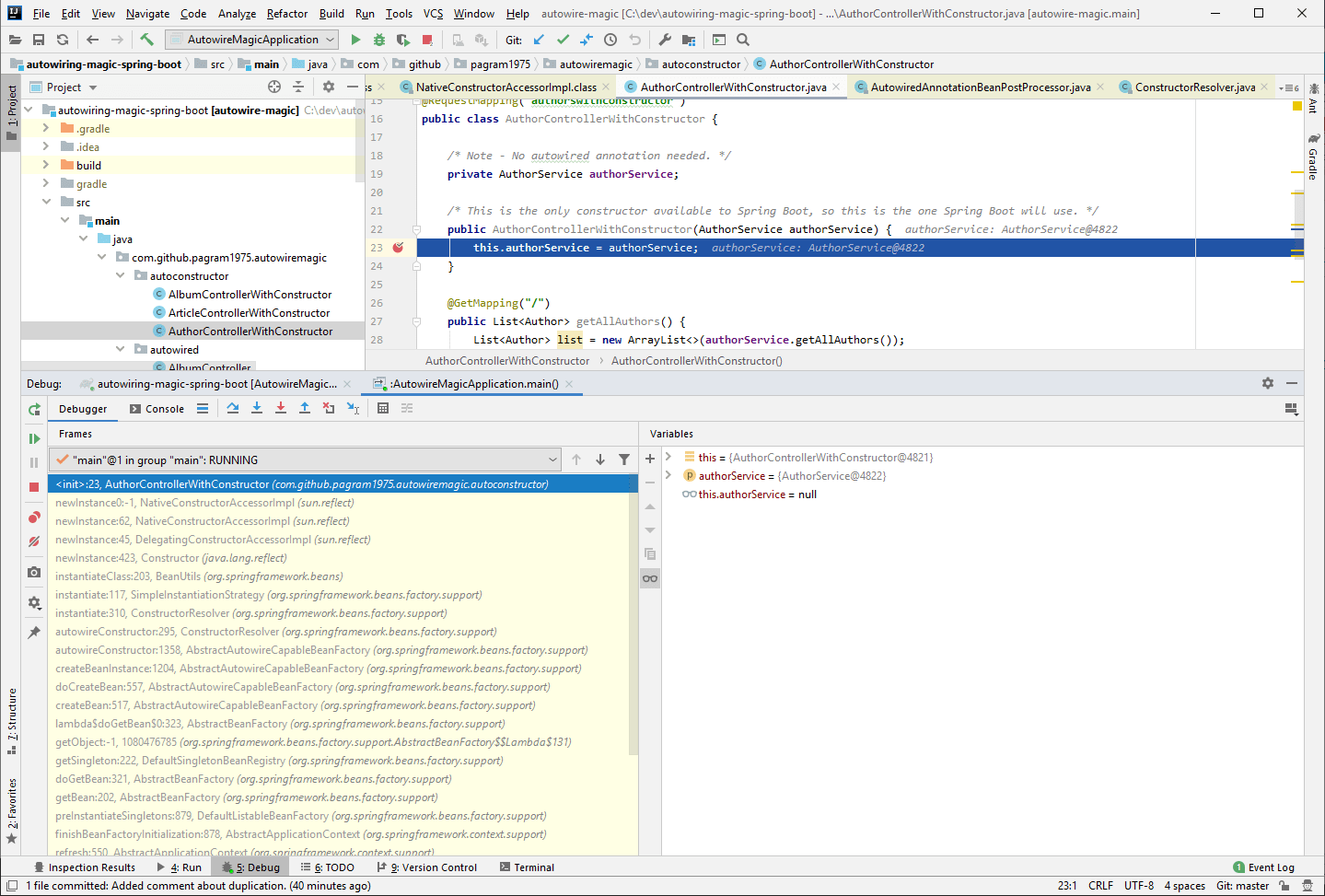
It’s clear from the stack that Spring has worked out that it must instantiate the AuthorControllerWithConstructor by calling its constructor, but how has it done this? Looking through the stack there are some descriptive class names that give some hints.
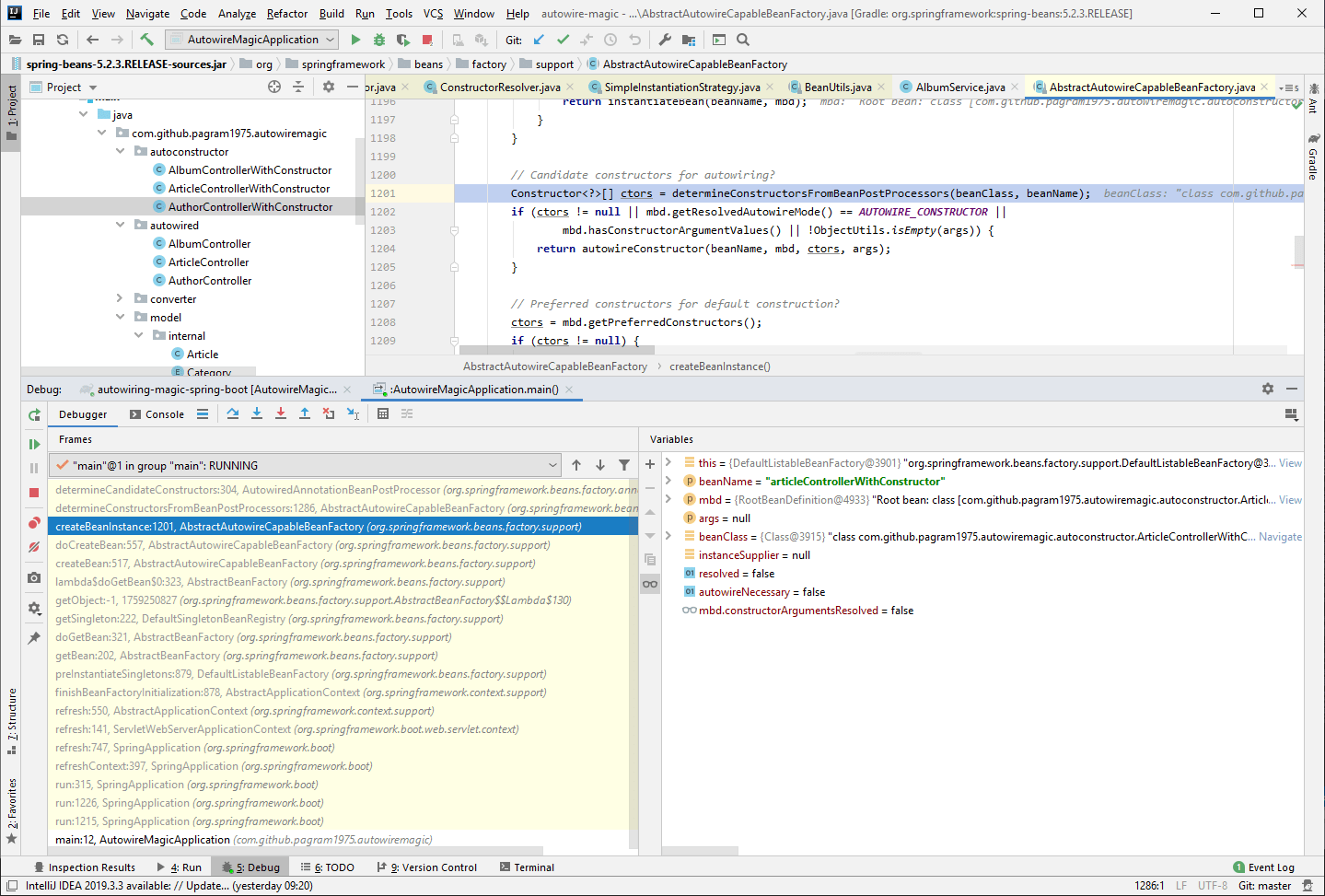
One method that stands out is createBeanInstance() on the AbstractAutowireCapableBeanFactory class. The thing that Spring is doing for us is creating a bean instance, in this case the bean is AuthorControllerWithConstructor. Looking at this there’s another method called from createBeanInstance() that has a very descriptive name determineCandidateConstructors().
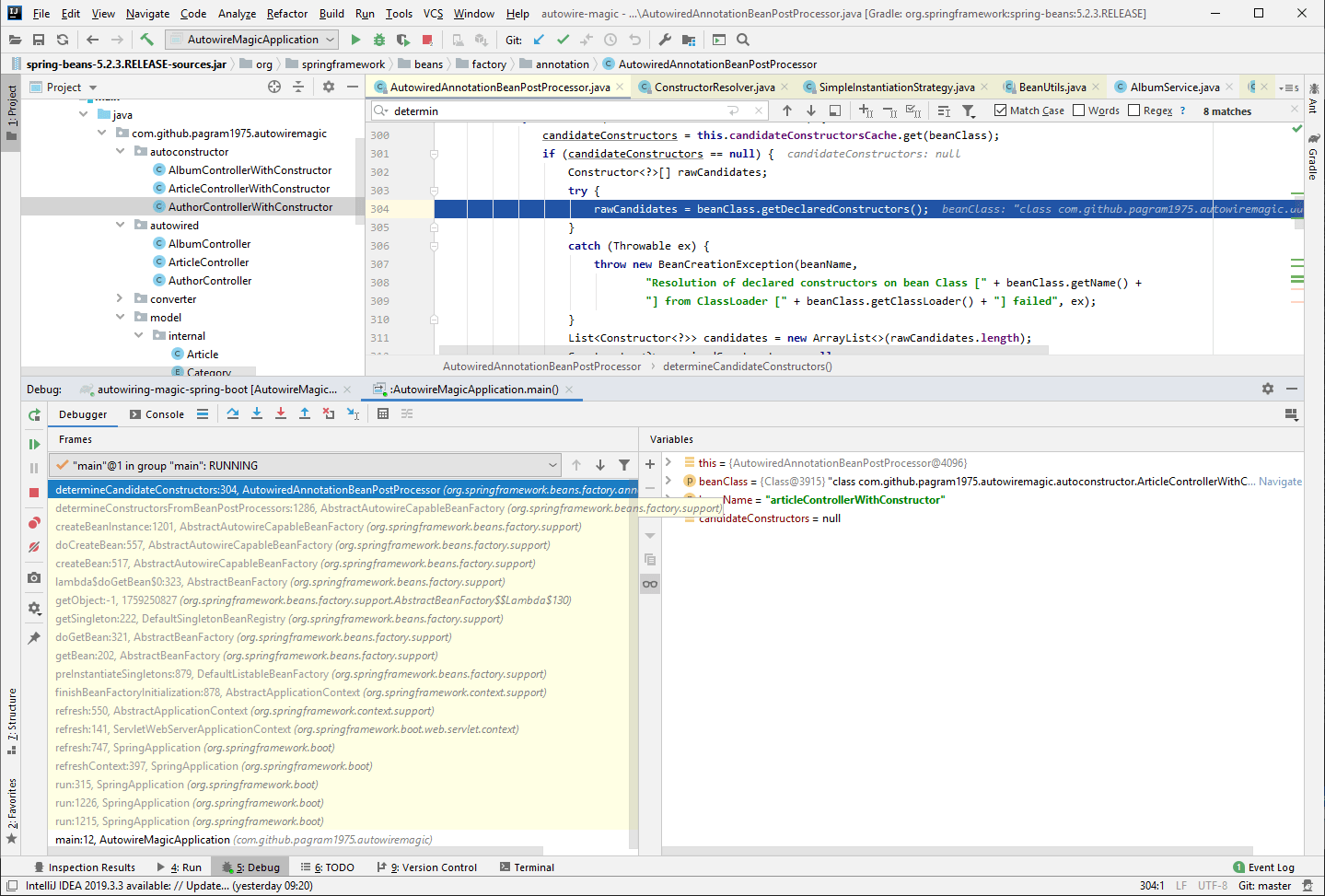
Again, Spring is using Java reflection to determine the constructors that are available to create the AuthorControllerWithConstructor. The above shows that the Spring code calls Class.getDeclaredConstructors(), a method that has been around since JDK1.1. Once a candidate constructor has been discovered Spring resolves the arguments (remember that there’s a cached AuthorService bean) and instantiates the class.
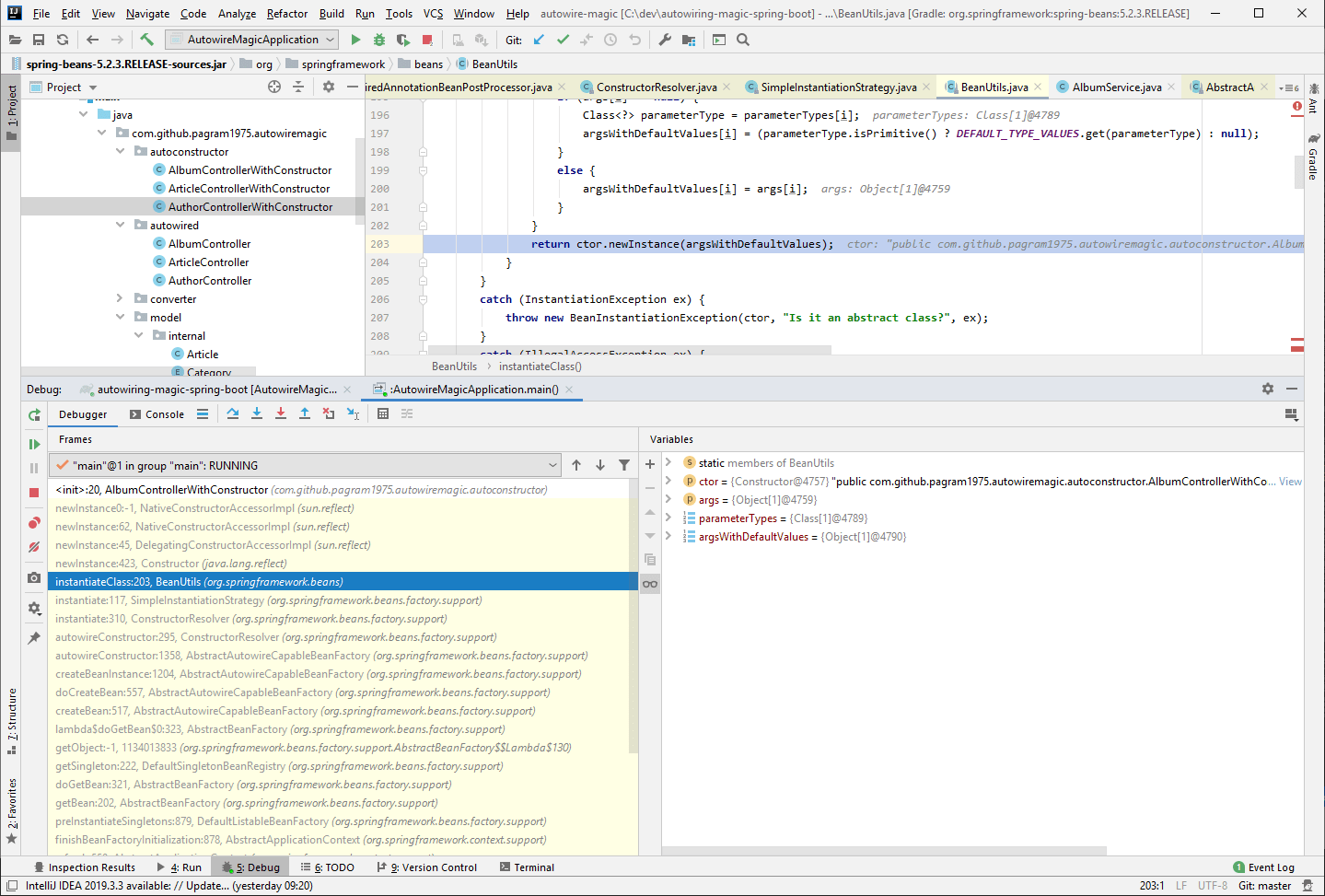
The class instantiation is done using Java reflection, too. The method used is Constructor.newInstance(). After looking into the Spring code that is executed, Autowiring a bean by a single constructor doesn’t seem so magical after all.
Summary
The first part of this post looked into the detail of how the Spring Framework resolves dependencies declared with the @Autowired annotation. The second part showed that Spring can also resolve dependencies for a target bean class that has just one constructor. In both cases Spring uses Java reflection to perform its task. You can find all the code for the classes referenced in this post on GitHub.
Dependency injection by @Autowired is a convenient way to wire beans together within a Spring application. It’s easy to use and powerful enough to, at times, appear somewhat magical. While it would be nice to believe in magic, it’s better to have a more detailed answer prepared for the question, “How does it work?”
Thanks for taking the time to read this post. The next post in this series will look into some of the quirks of Spring Autowiring and dependency injection, including cases where Spring copes with incomplete configuration details as if by magic.

